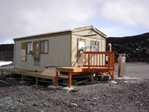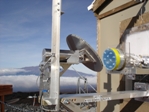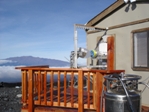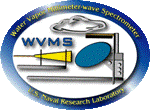More than two years after road access and electrical power to the Mauna Loa Observatory was cut off by lava flows, NOAA staff continue to make critical measurements of the atmosphere and other environmental variables at the remote site.
In 2023, observatory staff installed solar panels at the site and resumed some measurements, including the independent carbon dioxide monitoring programs run by the Global Monitoring Laboratory and Scripps Institution of Oceanography, as well as other atmospheric measurements.
Construction of a temporary road to access the observatory site is anticipated to begin in summer 2025.
Media can contact: Theo Stein (303) 819-7409 (theo.stein@noaa.gov)
Organization(s):
 Network For the
Detection of Atmospheric Composition Change (NDACC)
Network For the
Detection of Atmospheric Composition Change (NDACC) Naval Research
Laboratory
Naval Research
Laboratory NASA (National Aeronautics and Space Administration),
U.S. Department of Defense
NASA (National Aeronautics and Space Administration),
U.S. Department of DefenseWhat does this program measure?
The goal of the Water Vapor Millimeter-wave Spectrometer (WMVS) project is to measure water vapor in the middle atmosphere (between about 40 and 80 km), in parts per million. Since water vapor is the primary source of the hydroxide (OH) radical and other hydrogen compounds, it is important in controlling ozone chemistry. Because the chemical time scales for water vapor are long relative to time scales for transport in the middle atmosphere, it is also an excellent tracer of atmospheric motion. Water vapor profiles are obtained by measuring the emission of the 22 GHz transition of water vapor. The data has been obtained from nearly continual observations at the Network for the Detection of Atmospheric Composition Change (NDACC) sites in Table Mountain, California (Jan. 1992 - Nov 1997, Nov. 2003-present), in Lauder, New Zealand (since November 1992), and in Mauna Loa, Hawaii (since February 1996).
How does this program work?
The WVMS instrument is a microwave radiometer which measures water vapor emission at 22 Ghz with filters ranging from 200 kHz to 14 MHz, and a total bandwidth of 420 MHz. The measurements allow for the retrieval of water vapor mixing ratios with a resolution of 10-15 km at altitudes of 40-80 km. The system is computer controlled, with data brought back to NRL via a modem link. The instrument is calibrated weekly using an ambient and a liquid nitrogen target, and run continuously at MLO.
Why is this research important?
Water vapor plays a role both in the radiative and chemical balance of the middle atmosphere. Long-term changes in the amount of water vapor in the stratosphere can affect stratospheric temperatures, while its role as a reservoir of odd hydrogen makes it directly important to ozone chemistry. In the mesosphere water vapor provides a good tracer of atmospheric transport. These measurements are important primarily for trend detection and as an independent calibration of satellite trend detection.
Are there any trends in the data?
Large (2% per year) trends were observed in the early 1990s, but there has been no significant change since about 1996. Some of these trends are caused by changes in methane (CH4) and by changes in atmospheric transport, but about half of the 2% per year trend in the early 1990s is still not fully explained. In 2001 a decrease in lower stratospheric water vapor was detected in lower altitude datasets, but this decrease has to date not been clearly detected at the altitudes measured by WVMS.
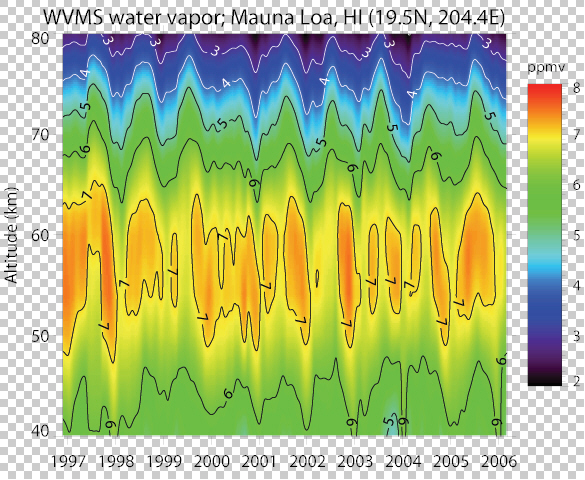
How does this program fit into the big picture?
What is it's role in global climate change?
Long-term changes in water vapor will affect ozone and therefore stratospheric temperatures. Also, the amount of water vapor in the middle atmosphere is very sensitive to temperature at the tropical tropopause.
Comments and References
Mauna Loa is an ideal site for these measurements both because its low latitude reduces the seasonal cycle (and thus makes trend detection easier) and because the high altitude reduces the amount of tropospheric water which we need to look through.
- Nedoluha, Gerald E., Richard M. Bevilacqua, R. Michael Gomez, Brian C.Hicks, James M. Russell, and Brian J. Connor, An evaluation of trends in middle atmospheric water vapor as measured by HALOE, WVMS, and POAM, Journal of Geophysical Research, Vol.108, No. D13, 4391, doi 10.1029/2002JD003332, 2003
- Nedoluha, Gerald E., Richard M. Bevilacqua, R. Michael Gomez, Brian C. Hicks, James M. Russell, and Brian J. Connor, Ground-based microwave observations of middle atmospheric water vapor in the 1990s, Geophysical Monograph 123, Atmospheric Science Across the Stratopause, 257-270, 2000.
- Nedoluha, Gerald. E., Richard. M. Bevilacqua, R. Michael. Gomez, Brian. C. Hicks, and James M. Russell III, Measurements of middle atmospheric water vapor from low latitudes and mid latitudes in the Northern Hemisphere, 1995-1998, J. Geophys. Res., 104, 19257-19266, 1999.
Lead Investigator(s):
Dr. Gerald Nedoluha
202-767-4246
Mike Gomez
202-767-3533
MLO Contact(s):
Dr. John E. Barnes
808-933-6965 (x222)
Web Site(s)
Date Started
1996

